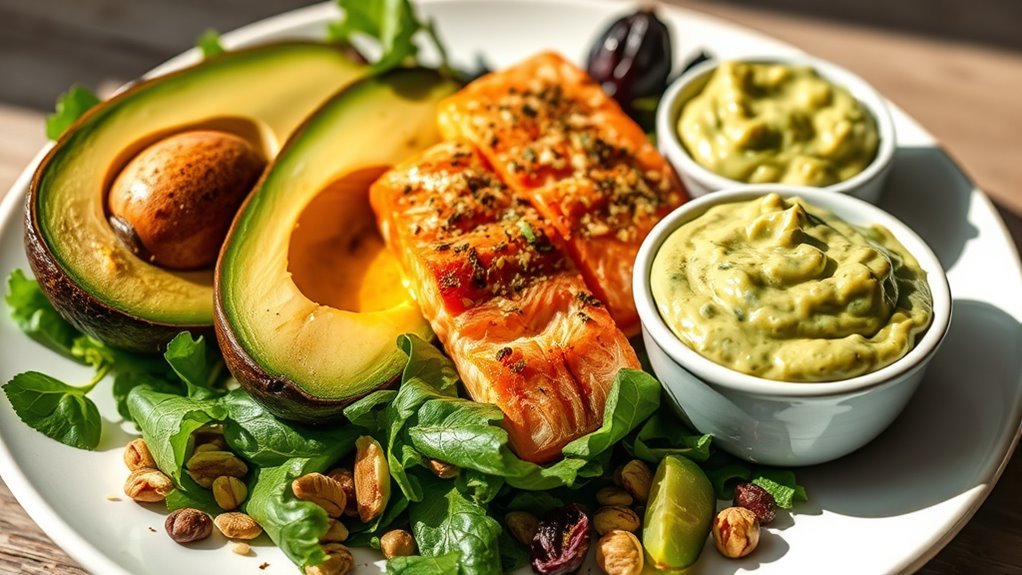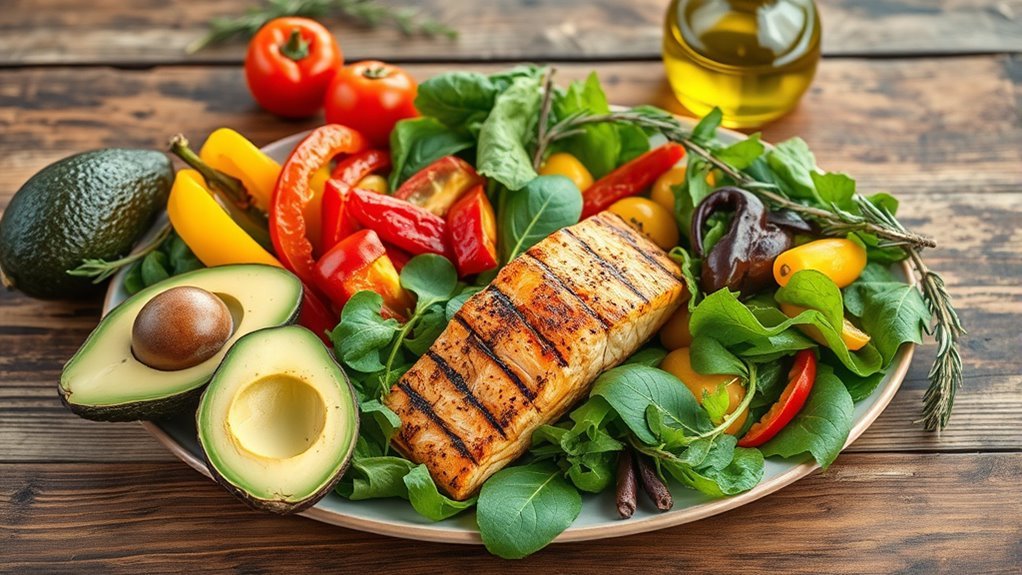Keto is a low-carbohydrate, high-fat diet that shifts your body into a metabolic state called ketosis. In ketosis, your body burns fat for energy instead of glucose, leading to potential benefits like weight loss, increased energy, and improved mental clarity. While you might experience cravings and initial fatigue, planning and support can help you adjust. There’s much more to learn about effectively maneuvering a keto lifestyle and reaping its rewards.
Understanding Ketosis

When you begin a ketogenic diet, understanding ketosis is essential to your success. Ketosis is a metabolic state where your body shifts from using glucose as its primary energy source to burning fat. This occurs when carbohydrate intake is greatly reduced, leading to the production of ketones. Recognizing ketosis symptoms can help you gauge your progress; common signs include increased energy, reduced hunger, and mental clarity. You might also experience mild side effects like fatigue or irritability during the initial change phase, often referred to as the “keto flu.” By being aware of these symptoms, you can embrace the freedom that comes with this diet and make adjustments as needed, ensuring a smoother journey toward your health goals.
The Science Behind the Keto Diet

Understanding the science behind the keto diet involves looking at how ketosis works and what you’re eating. When your body enters ketosis, it shifts from using carbohydrates for energy to burning fat, which can lead to weight loss. Additionally, the nutritional composition of the diet plays an essential role in maintaining this metabolic state.
Ketosis Mechanism Explained
Though many people have heard of the keto diet, the underlying mechanism of ketosis often remains unclear. Fundamentally, when you markedly reduce carbohydrate intake, your body enters a state called ketosis. In this state, it starts breaking down fats into ketones, which become your primary energy source. This shift can lead to several ketosis benefits, including improved mental clarity and weight loss. However, ketosis myths abound, such as the belief that it’s harmful in the long term. Research indicates that, for many, ketosis is safe and can provide sustained energy. Understanding how ketosis works empowers you to make informed choices, embracing a lifestyle that promotes freedom and health without unnecessary restrictions.
Nutritional Composition Overview
To effectively achieve and maintain ketosis, it’s essential to grasp the nutritional composition of the keto diet. This diet typically emphasizes keto macronutrient ratios of about 70-75% fats, 20-25% protein, and only 5-10% carbohydrates. By prioritizing high-fat content, your body shifts from burning glucose to utilizing fat for energy.
Keto food sources include avocados, nuts, seeds, fatty fish, and low-carb vegetables, which help you stay within these macronutrient guidelines. It’s vital to choose whole, unprocessed foods to maximize nutrient intake while adhering to these ratios. Understanding this composition not only supports your journey toward ketosis but also encourages a sustainable, enjoyable lifestyle that gives you the freedom to explore diverse flavors while thriving on a low-carb plan.
Potential Benefits of Going Keto

Many people turn to the ketogenic diet for its potential health benefits, particularly when it comes to weight loss and metabolic health. Adopting keto can lead to reduced cravings, helping you manage your appetite more effectively. Many report improved energy levels and mental clarity, making it easier to focus throughout the day. Better digestion and inflammation reduction are also commonly noted, contributing to overall well-being. Additionally, keto promotes hormonal balance, which can support weight management and mood. Enhanced endurance is another benefit, especially for those engaged in physical activities. Finally, this diet may support heart health and aid in blood sugar regulation, making it an attractive option for those looking to reclaim their health and liveliness.
Common Challenges and Drawbacks
While the ketogenic diet offers numerous potential benefits, it’s important to recognize that it also comes with its share of challenges and drawbacks. One common issue you might face is keto cravings, especially during the initial adaptation phase. These cravings can make it difficult to stick to the diet, leading to frustration. Additionally, maneuvering social situations can be tricky; many gatherings are centered around carb-heavy foods, which might leave you feeling left out or pressured to indulge. This can create a sense of isolation, impacting your social life. It’s essential to plan ahead and find ways to manage these challenges, ensuring that your keto journey remains enjoyable and sustainable. Balancing freedom with discipline is key to overcoming these hurdles.
Foods to Eat on a Keto Diet
When following a ketogenic diet, focusing on the right foods is essential for achieving and maintaining ketosis. Emphasizing low-carb, high-fat options can help you feel satisfied while keeping your carb intake in check. Here’s a quick guide to foods you should consider:
| Food Category | Examples |
|---|---|
| Proteins | Eggs, chicken, fatty fish |
| Vegetables | Spinach, broccoli, zucchini |
| Fats | Avocado, olive oil, butter |
| Snacks | Nuts, cheese crisps, beef jerky |
| Desserts | Keto cheesecake, fat bombs |
Incorporating keto snacks and desserts can satisfy cravings without derailing your progress. Make smart choices, and you’ll enjoy the freedom that comes with a balanced approach to keto.
Foods to Avoid on a Keto Diet
To successfully maintain ketosis, it’s essential to steer clear of certain foods that can hinder your progress. Avoiding high-carb snacks and making smart keto beverage choices will keep you aligned with your goals. Here’s a list of foods to watch out for:
- Sugary drinks and sodas
- Bread and pasta
- Starchy vegetables like potatoes and corn
- High-sugar fruits such as bananas and grapes
- Most processed snacks
How to Transition to a Keto Lifestyle
Shifting to a keto lifestyle requires careful meal planning to guarantee you get the right nutrients while staying within your carb limits. It’s also important to be prepared for the keto flu, which can occur as your body adapts to burning fat for fuel. Understanding these essentials will help you make a smoother change and maintain your new dietary habits.
Meal Planning Essentials
Successfully adopting a keto lifestyle hinges on effective meal planning, and there are several key essentials to contemplate. To guarantee you’re on the right track, focus on these five meal planning essentials:
- Keto grocery list: Stock up on low-carb, high-fat foods.
- Meal prep: Dedicate time weekly to prepare your meals, reducing the temptation to stray.
- Portion control: Keep servings in check to maintain ketosis.
- Variety: Incorporate a range of recipes to prevent boredom.
- Snacks: Plan keto-friendly snacks to curb cravings between meals.
Managing Keto Flu
As you shift into a keto lifestyle, you may experience what’s commonly known as the “keto flu,” a collection of symptoms that can arise during the initial phase of carbohydrate restriction. To manage these keto symptoms, focus on hydration strategies and electrolyte balance. Here are some recovery techniques that can help:
| Strategy | Purpose | Recommendations |
|---|---|---|
| Hydration | Prevent dehydration | Drink plenty of water |
| Electrolyte balance | Alleviate fatigue | Consume sodium, potassium, and magnesium |
| Rest recommendations | Support recovery | Get adequate sleep |
| Dietary supplements | Enhance nutrient intake | Consider electrolytes and multivitamins |
Tips for Sustaining a Keto Diet
While adopting a keto diet can be exciting, sustaining it over the long term often presents unique challenges. To help you maintain your keto lifestyle, consider the following tips:
- Prioritize keto meal prep to simplify your meals and avoid temptation.
- Stay mindful of hydration importance; drink plenty of water to stay energized and curb cravings.
- Keep a variety of low-carb snacks on hand to prevent boredom.
- Track your macros to guarantee you’re staying within your carb limits.
- Connect with a supportive community for motivation and accountability.


